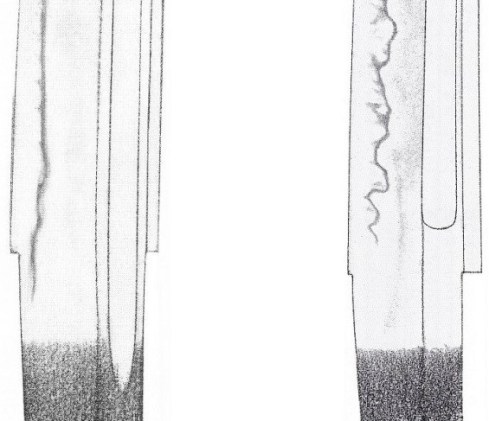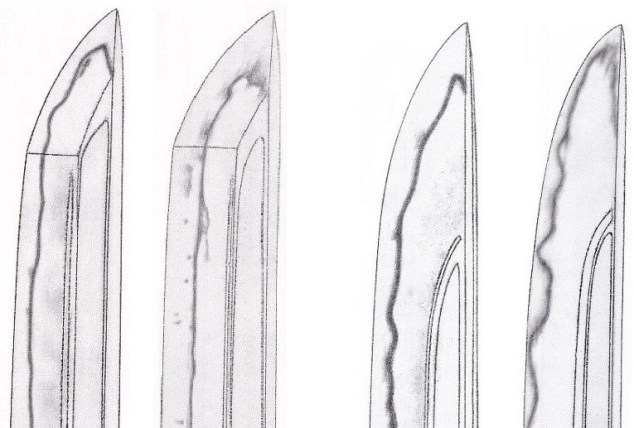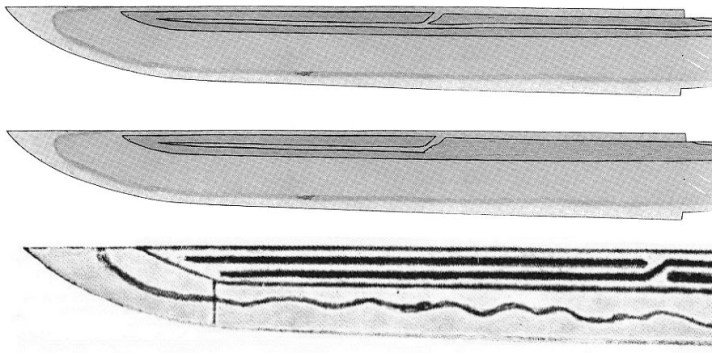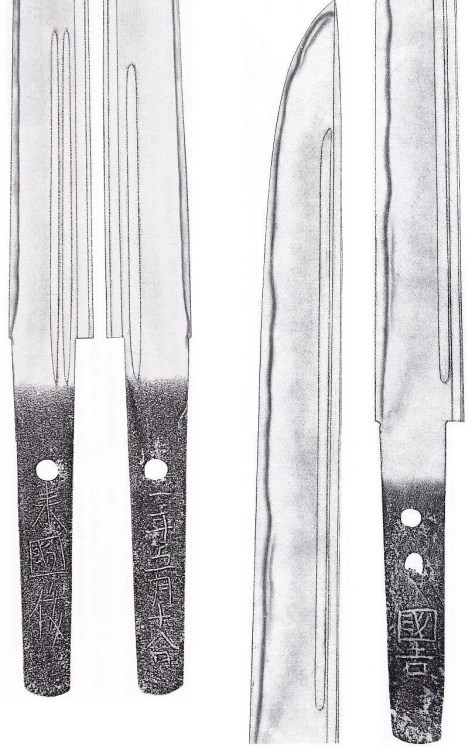1.7 Hi and horimono
First of all some terminology issues need to be clarified. The term horimono (彫物) is an umbrella term and refers to both grooves (hi, 樋) and engravings but the latter are also referred to as by the very same term horimono (彫物), or as by the term tôshin-bori (刀身彫). I am using the term horimono in the latter sense, that means I am always refer to engravings and never to grooves.
horimono (彫物)
⌈¯¯¯¯¯¯¯¯¯¯¯¯¯¯¯¯¯¯¯¯¯¯¯¯¯¯¯¯⌉
hi (樋) horimono (彫物) / tôshin-bori (刀身彫)
*
1.7.1 Hi (grooves)
Well, also hi and horimono allow to a certain extent conclusions on the school or smith or the production time of a blade. The most common hi is that of a wide bôhi (棒樋) which was applied by so many schools and smiths and makes it impossible to quote any representative names. By the way, in the case of carved to a tantô or hira-zukuri ko-wakizashi, a wide bôhi is referred to as katana-hi (刀樋). One has to pay attention to how a bôhi was carved into a shinogi-zukuri blade. That means it can be carved directly along the shinogi or slightly set-off. This little leftover of the shinogi-ji is called chiri (チリ). Is the bôhi carved directly along the shinogi and leaves only a chiri towards the mune, we speak of kata-chiri (片チリ), and is the bôhi carved centrally on the shinogi-ji leaving a chiri along the shinogi and along the mune, we speak of ryô-chiri (両チリ). By the way, it is hardly ever seen that a bôhi extends from the shinogi to the very edge of the mune, i.e. leaving no chiri at all, or directly from the edge of the mune leaving just a chiri along the shinogi. A conspiciously wide bôhi is typical for Miike Tenta Mitsuyo (三池典太光世), Osafune Mitsutada (光忠), and Higo no Daijô Sadakuni (肥後大掾貞国), and a noticeably thin bôhi is typical for Sôshû smiths. But we can also see certain tendencies when it comes to the chiri. A kata-chiri is far more often seen on kotô blades with bôhi than on shintô blades. As this feature is so typical for kotô-bôhi, it is again hard to quote any representative names. When it comes to shintô, kata-chiri interpretations are typical for the Horikawa (堀川) school, the Hizen Tadayoshi (忠吉) school, Ogasawara Nagamune (小笠原長旨), Ippei Yasuyo (一平安代), and Yokoyama Sukesada (横山祐定), and are occasionally also seen on blades of Hankei (繁慶) and Kotetsu (虎徹). For shinshintô, we see kata-chiri preferrably at Suishinshi Masahide (水心子正秀), Taikei Naotane (大慶直胤), Oku Motohira (奥元平), Hôki no Kami Masayoshi (伯耆守正幸), and Gassan Sadakazu (月山貞一). For the kotô era, a ryô-chiri is more often seen at non-gokaden than gokaden smiths, for example at the Aoe (青江) school, the Enju (延寿) school (Kunitoki [国時], Kunimura [国村]), the Naminohira (波平) school, at Kashû Yukimitsu (加州行光), or at Kongôbyôe Moritaka (金剛兵衛盛高). Also we learn that a ryô-chiri is more often found on blades from the provinces of Kaga, Echizen, Etchû, Hôki, and Iwami, and on Sue-Niô (末二王) blades. When it comes to shintô, ryô-chiri interpretations are typical for Hankei, Ogasawara Nagamune, Sasaki Ippô (佐々木一峯), Higo no Daijô Sadakuni (肥後大掾貞国), Yamato no Daijô Masanori (大和大掾正則), and Echizen no Daijô Tadakuni (越前大掾忠国). But be careful: There is always the chance that a bôhi with ryô-chiri was later widened and became so a kata-chiri bôhi. Anyway, hi were often added later, a feature called ato-bi (後樋), so grooves are of course only indicators for kantei when they are original to the blade.
ryô-chiri left, kata-chiri right
Next thing to focus on is how a hi ends. Well, often a hi runs into the nakago – either due to shortening or intended by the smith – but if it ends before the habaki, it does that either in a roundish (maru-dome, 丸留), or in an angular manner (kaku-dome, 角留). Representative schools and smiths for a maru-dome are: Many Bizen smiths from the mid-Kamakura and Muromachi period, Nobukuni (信国), Heianjô Nagayoshi (平安城長吉), the Sue-Tegai (末手掻) school, the Kanabo (金房) school, the Horikawa (堀川) school, Ikkanshi Tadatsuna (一竿子忠綱), Tsutsui Kijû (筒井紀充), Echizen Yasutsugu (康継), Hankei (繁慶), Kotetsu (虎徹), Ogasawara Nagamune (小笠原長旨), the Hôjôji (法城寺) school, Suishinshi Masahide (水心子正秀), and Taikei Naotane (大慶直胤). Please note that a maru-dome might end noticeably higher at Kagemitsu (景光), Kanemitsu (兼光), Horikawa Kunihiro, and Kotetsu. And representative schools and smiths for a kaku-dome ending are: Tomonari (友成), Nagamitsu (長光), Kagemitsu (景光), the Ôei-Bizen (応永備前) school, Yoshii Kiyonori (清則), the Sue-Bizen (末備前) school (Kiyomitsu [清光]) Ôei-Nobukuni (信国), Ryûmon Nobuyoshi (龍門延吉), Shimada Yoshisuke (島田義助), the Ko-Mihara (古三原) school, Arikuni (顕国), the Taira-Takada (高田) school (Sadamori [定盛]), Inshû Kanenaga (因州兼長), Kanro Toshinaga (甘露俊長), Fujishima Tomoshige (藤島友重), Zenjô Kaneyoshi (善定兼吉), Dewa no Daijô Kunimichi (出羽大掾国路), Etchû no Kami Masatoshi (越中守正俊), Ogasawara Nagamune (小笠原長旨), the Hôjôji (法城寺) school, Yokoyama Sukesada (横山祐定), the Chikuzen Nobukuni (筑前信国) school, Hizen Tadahiro (忠広), Taikei Naotane (大慶直胤), Koyama Munetsugu (固山宗次), Kiyondo (清人), and Gassan Sadakazu (月山貞一).
maru-dome left, kaku-dome right
The next to check is how the hi ends towards the kissaki. There are basically two ways: Exceeding the yokote and more or less close to the ko-shinogi, a feature which is called hisaki-agaru (樋先上る), or before the yokote what is called hisaki-sagaru (樋先下る). Please note that a hisaki-agaru can be the result of a reshaped kissaki. That means the hi originally may have ended as hisaki-sagaru but due to a repair in the tip material had to be removed and the tip ends now at or towards the ko-shinogi. But when you look closely you can usually see if a hisaki-agaru ends in a straight and kind of awkward manner right at the ko-shinogi ridge (or even exceeds it a little), or if the hisaki-agaru tip leaves a chiri and runs parallel to the ko-shinogi. Hisaki-agaru is usually more often seen on kotô than on shintô blades and representative schools and smiths are: The Rai (来) school (Kuniyuki [国行], Kunitoshi [国俊], Kunimitsu [国光]), Nobukuni (信国), the Ko-Bizen (古備前) school, the Ichimonji (一文字) school, the Ko-Osafune (古長船) school (Mitsutada [光忠], Nagamitsu [長光], Kagemitsu [景光]), Kanemitsu (兼光), Kunimune (国宗), Hatakeda Moriie (畠田守家), the Ôei-Bizen (応永備前) school, Ryûmon Nobuyoshi (龍門延吉), the Enju school (延寿), Yukimitsu (行光), Horikawa Kunihiro (堀川国広), Etchû no Kami Masatoshi (越中守正俊), Echizen Yasutsugu (越前康継), Higo no Daijô Sadakuni (肥後大掾貞国), Hankei (繁慶), Teruhiro (輝広), Hizen Tadayoshi (忠吉), Suishinshi Masahide (水心子正秀), Taikei Naotane (大慶直胤), Koyama Munetsugu (固山宗次), and Kiyomaro (清麿). A noticeable hisaki-sagaru is typical for blades from the mid-Nanbokuchô period and representative schools and smiths are: The Tegai (手掻) school, the Shikkake (尻懸) school, Gô Yoshihiro (郷義弘), Tsunahiro (綱広), the Chôgi (長義) school, the Kanemitsu (兼光) school, the Motoshige (元重) school, the Aoe school (青江), the Sue-Aoe (末青江) school, the Sue-Sa (末左) school, the Sue-Seki (末関) school, Dewa no Daijô Kunimichi (出羽大掾国路), the Echizen Yasutsugu (康継) school, the Hôjôji (法城寺) school, Hizen Tadayoshi (忠吉), swords from Satsuma, and Sa Yukihide (左行秀).
From left to right: hisaki-agaru (Ko-Bizen) hisaki-agaru (Kagemitsu), hisaki-sagaru (Chôgi) hisaku-sagaru (Aoe)
So far the basic features to check when examining a hi and now to the different kind of grooves which are introduced one by one. First the bôhi-related grooves. An interpretation which is called bôhi ni soebi (棒樋に添樋) is to carve a thin hi parallel along a bôhi and the thinner hi can either lie with the bôhi in the shinogi-ji or, directly at the shinogi, or slightly under the shinogi. A bôhi ni soebi is very rarely seen in Kamakura times and was more or less introduced by the Bizen smiths of the Nanbokuchô era. The interpretation had its heyday in the Muromachi period and is rare for the Mishina (三品) school, Ôsaka-shintô blades and blades from Satsuma province. Representative schools and smiths are: The Hasebe (長谷部) school, Nobukuni (信国), Sanjô Yoshinori (三条吉則), the Sue-Tegai (末手掻) school, the Sue-Shikkake (末尻懸) school, the Kanabo (金房) school, the Sue-Seki (末関) school, the Takada (高田) school, the Sue-Mihara (末三原) school, Horikawa Kunihiro (堀川国広), Dewa no Daijô Kunimichi (出羽大掾国路), the Hôjôji (法城寺) school, Miyoshi Nagamichi (三善長道), Aizu Masanaga (政長), Yamato no Daijô Masanori (大和大掾正則), Echizen Kanenori (越前兼則), Yamashiro no Kami Kunikiyo (山城守国清), the Chikuzen Nobukuni (筑前信国) school, the Hizen Tadayoshi (忠吉) school, or Taikei Naotane (大慶直胤).
A variant of the bôhi ni soebi is the bôhi ni tsurebi (棒樋に連樋), that is when the thinner soebi runs at the tip in front of the end of the bôhi up to the mune. The bôhi no tsurebi interpretation became more popular towards the end of the Muromachi period but is also seen on blades of famous Kamakura and Nanbokuchô-era master smiths. Representative schools and smiths are: The Rai (来) school (Kuniyuki [国行], Kunitoshi [国俊]), Nobukuni (信国), Sukezane (助真), the Ko-Osafune (古長船) school (Mitsutada [光忠], Nagamitsu [長光], Kagemitsu [景光], Sanenaga [真長]), Kanemitsu (兼光), Morimitsu (盛光), Yasumitsu (康光), Norimitsu (則光), Tsunahiro (綱広), the Horikawa (堀川) school, Ikkanshi Tadatsuna (一竿子忠綱), the Hôjôji (法城寺) school, the Chikuzen Nobukuni (筑前信国) school, and shinshintô smiths when working in the Bizen tradition like Suishinshi Masahide (水心子正秀), Taikei Naotane (大慶直胤), or Koyama Munetsugu (固山宗次). A bôhi ni tsurebi is sometimes also seen on blades of the Mishina (三品) school, of Nanki Shigekuni (南紀重国), Sendai Kunikane (国包), the Mizuta (水田) school, and on works from Satsuma smiths.
Left two: bôhi ni soebi (Ôei-Bizen and Taira-Takada)
Right two: bôhi no tsurebi (Rai Kuntisugu and Naoe-Shizu Kanetomo)
Two parallel grooves of the same thickness are called futasuji-hi (二筋樋) and appear towards the end of the Kamakura period. Thus futasuji-hi on noticeably earlier swords are probably ato-bi. Also please note that futasuji-hi were later occasionally added to blades to “underline” a certain approach. In other words, an early Nanbokuchô-style blade that showed characteristics similar to Sadamune for example could have been “enlarged” with futasuji-hi as some famous blades of this master were known for this feature. Schools and smiths known for carving futasuji-ji are: Rai Kuninaga (来国長), Nobukuni (信国), Sadamune (貞宗), Tsunahiro (綱広), Kaneuji (兼氏), the Naoe Shizu (直江志津) school, Kinjû (金重), Izumi no Kami Kanesada (和泉守兼定), Wakasa no Kami Ujifusa (若狭守氏房), the Sengo (千子) school (Muramasa [村正], Masazane [正真]), Fujishima Tomoshige (藤島友重), Inshû Kanenaga (因州兼長), for Bizen Nagamitsu (長光), Chôgi (長義), Tomomitsu (倫光), Kanemitsu (兼光), Yoshimitsu (義光), and Morikage (盛景), the Chû (中) and the Sue-Aoe (末青江) schools, Dewa no Daijô Kunimichi (出羽大掾国路), Etchû no Kami Masatoshi (越中守正俊), the Yasutsugu (康継) school, the Hôjôji (法城寺) school, Miyoshi Nagamichi (三善長道), Aizu Kanesada (兼定), Kashû Kanewaka (兼若), the Echizen-Seki (越前関) school, the Echizen-Shimosaka (越前下坂) school, the Chikuzen Nobukuni (筑前信国) school, the Fujiwara-Takada (高田) school, the Hizen Tadayoshi (忠吉) school, Mondo no Shô Masakiyo (主水正正清), Taikei Naotane (大慶直胤), Minamoto Kiyomaro (源清麿), Oku Motohira (奥元平), and Oku Mototake (奥元武).
Examples of futasuji-hi, from top to bottom: Nagamitsu, Aoe, Fujishima Tomoshige
A variant of the futasuji-hi which is mostly found on hira-zukuri tantô or wakizashi is the take-kurabe (丈比べ, lit. “comparison of height”) where one thin hi ends noticeable before the other.
A take-kurabe on a sunnobi-tantô of Kanefusa (兼房, also named Kenbô).
Another variant of the futasuji-hi is the shôbu-hi (菖蒲樋), that is when the tips of the two small grooves merge. Representative for adding shôbu-hi are the following schools and smiths: Rai Kunimitsu (来国光), Awataguchi Norikuni (則国), for Yamato the Taima (当麻), Hoshô (保昌), and Shikkake (尻懸) school, Sôshû Akihiro (秋広) and Hiromitsu (広光), Takagi Sadamune (高木貞宗), and the Miike (三池) school of Chikugo province. There is a variant of the shôbu-hi that comes in several interpretations and that is called kuichigai-bi (喰違樋). At one interpretation, the upper hi of a shôbu-hi, i.e. the one along the mune, is interrupted at a certain point (see picture below, top). At another interpretation, the bottom hi widens to a bôhi after the upper hi (see picture below, center). And at a third kuichigai-bi interpretation, the thin grooves are “crossing” somewhere on the blade (see picture below, bottom). In addition to those schools and smiths who applied shôbu-hi, a kuichigai-bi is also seen on blades by: Nobukuni (信国), Heianjô Nagayoshi (平安城長吉), Sanjô Yoshinori (三条吉則), the Hoshô (保昌) school, the Sue-Tegai (末手掻) school, the Kanabo (金房) school, the Sue-Mihara (末三原) school, the Uda (宇多) school, the Hiroyoshi (広賀) school, the Sue-Enjû (末延寿) school, Dewa no Daijô Kunimichi (出羽大掾国路), Etchû no Kami Masatoshi (越中守正俊), the Yasutsugu (康継) school, shintô blades from Echizen province, Taikei Naotane (大慶直胤), Kurihara Nobuhide (栗原信秀), and Gassan Sadakazu (月山貞一).
shôbu-hi
Three kuichigai-ba variants.
A koshi-bi (腰樋) is a short bôhi variant carved towards the base of a blade. It is usually carved on just the omote side with anoher hi variant on the ura and mostly seen on hira-zukuri tantô or ko-wakizashi, although also some kotô-era tachi show a koshi-bi. Representative schools and smiths for a koshi-bi are: The Awataguchi (粟田口) school, the Rai (来) school, Nobukuni (信国), Heianjô Nagayoshi (平安城長吉), Sanjô Yoshinori (三条吉則), Shintôgo Kunimitsu (新藤五国光) the Sue-Tegai (末手掻) school, Umetada Myôju (埋忠明寿), the Horikawa (堀川) school, Yasutsugu (康継), Ômi no Kami Tsuguhira (近江守継平), Sagami no Kami Masatsune (相模守政常), Higo no Daijô Sadakuni (肥後大掾貞国), Yamato no Daijô Masanori (大和大掾正則), Kanenori (兼則), Ujishige (氏重), Teruhiro (輝広), the Hizen Tadayoshi (忠吉) school, Suishinshi Masahide (水心子正秀), and Taikei Naotane (大慶直胤).
A popular combination to the koshi-bi are gomabashi (護摩箸), stylized ritual chopsticks which are basically a shorter futasuji-ji variant. Gomabashi are like koshi-bi rare for tachi and katana and mostly seen on hira-zukuri tantô or ko-wakizashi. Representative schools and smiths known for carving gomabashi are: The Awataguchi (粟田口) school (Kuniyoshi [国吉], Yoshimitsu [吉光]), the Rai (来) school (Rai Kunitoshi [来国俊], Kunimitsu [国光]), Nobukuni (信国), the Hasebe (長谷部) school, Heianjô Nagayoshi (平安城長吉), Sanjô Yoshinori (三条吉則), Shintôgo Kunimitsu (新藤五国光), the Masamune (正宗) school (Yukimitsu [行光], Sadamune [貞宗]), Kagemitsu (景光), the Ôei-Bizen (応永備前) school, the Sue-Bizen (末備前) school, Izumi no Kami Kanesada (和泉守兼定), Shimada Yoshisuke (島田義助), the Horikawa (堀川) school, Hizen Tadayoshi (忠吉), shintô swords from Echizen province, Suishinshi Masahide (水心子正秀), and Taikei Naotane (大慶直胤). Please note that Yamashiro smiths often combined the gomabashi with a suken on the other, i.e. the omote side. Apart from that it has to be mentioned that the Awataguchi smiths carved their katana-hi closer to the mune than the Rai smiths when it comes to grooves on Kamakura-period Yamashiro tantô.
Left: koshi-bi gomabashi combination on a Rai Kunitoshi;
right: katana-hi very close to the mune on a blade by Awataguchi Kuniyoshi
Another groove interpretation is the naginata-hi (薙刀樋), named after the fact that it is mostly found carved along the shinogi-ji of naginata before it sets off and thins out to the mune. But a naginata-hi is sometimes also found on blades in kanmuri-otoshi-zukuri and unokobi-zukuri. Representative schools and smiths for a naginata-hi are: Nobukuni (信国), Heianjô Nagayoshi (平安城長吉), Sanjô Yoshinori (三条吉則), the Sue-Tegai (末手掻) school, the Kanabo (金房) school, the Sue-Seki (末関) school, the Uda (宇多) school, Hôjôji Kunimitsu (法城寺国光), Ryôsai (良西), the Hiroyoshi (広賀) school, the Sue-Mihara (末三原) school, the Sue-Sa (末左) school, the Horikawa (堀川) school, Miyoshi Nagamichi (三善長道), Aizu Michitoki (道辰), Suishinshi Masahide (水心子正秀), Taikei Naotane (大慶直胤), Kurihara Nobuhide (栗原信秀), and Gassan Sadakazu (月山貞一).
Rather long naginata-hi on a kanmuri-otoshi-zukuri tantô of Ryôsai.










Pingback: What the Nakago’s (Tang) Condition Reveals About Japanese Swords? - Swordis